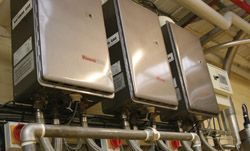Who needs hot water? In a word - everyone, from the showers and taps we run at home and work, to the more demanding markets of food processing and farming. So it would seem that water heaters are not as niche as some would suggest.

Rinnai supply water heaters for food processing
Consumer needs for hot water are increasing and expert in the field, Rinnai, believes continuous flow water heaters (CFWH) will spell an end to hot water shortage. The versatility of continuous flow water heaters means they can be utilised for the majority of systems where hot water is required and in most cases can improve the overall efficiency of any system, even renewables!
Make the most of what you've got
Now renewables have arrived in force, the CFWH manufacturers have an important role to play. The setback for renewables has always been the levels of efficiency when the conditions are not ideal.
Take the UK solar patterns for example; very erratic and unpredictable. But this does not mean it is a less viable option; it is free energy after all! Contractors and system designers simply need to make the most of what we have, and water heaters can do this in a special way.
Using solar as an example, panels draw their power from the sun, then store the resultant hot water in large buffer vessels which need constant topping up in order to maintain the correct temperature.

CFWH provides the hot water for breadcrumb manufacturing
Temperatures might reach only 20°C to 30°C, requiring a lot of additional energy to achieve desired temperature. Normally this is supplemented by an additional heat source ran at 100 per cent; generally a boiler, but this could also be supplemented by an electrical immersion heater. The CFWH system is different. By adding a solar thermal store and a gas-fired, non-storage water heater on the flow to the building, the water heated by the panels (whatever the conditions) is used and topped up by the water heater.
As and when there is demand on the hot water system (a hot tap is turned on), water is drawn from the thermal store through the water heater where any short-fall in temperature difference is made up. The result is the absent energy only is made up by the water heater, which might be as little as 10°C, so minimising the gas used. This approach automatically flexes the input from the water heater from nil to its full output depending on the amount of solar energy that is captured. So during a fine sunny day in winter even the smallest amount of solar input is made use of without complicated controls in place, and to within a 1°C of set temperature.
Food for thought
We've established that the precise nature of specialist water heaters - even when combined with renewables - is unsurpassable by more traditional methods, so how can this be used in industry? How about the process of food manufacture? Yeast-based food production in particular needs optimal temperatures, to produce the perfect cake, bun or even breadcrumb. Making crumbs on an industrial scale is not art, it's a science and a world-renowned food manufacturer chose CFWH to provide the vital hot water temperature control for one of its bread crumb manufacturing plants.
Two Rinnai Infinity HD50i heaters act as a secondary hot water source at one of the manufacturing plants. The primary heat source is via the use of waste heat from an existing compressed air plant. The hot water is stored in a 1,500 litre stainless steel calorifier. The hot water is pumped the length of the factory where it is mixed with other ingredients to achieve the required recipe dough temperature. If the return hot water temperature falls below 55°C, the two Rinnai heaters automatically fire and maintain the calorifier temperature at 60°C. The Rinnai Infinity has an operating efficiency of more than 80 per cent, an improvement in running costs of 20 per cent over the old multipoints.
Modern twist
Beyond the kitchens, milking parlours and food manufacturers' requirements for hot water, the more traditional use for continuous flow has always been to maintain a steady flow of hot water coming from our taps and showers. This technology is now entering its second phase with the introduction of condensing units. As demands for hot water is increasing, the percentage between space heating and hot water in terms of energy use is shrinking, making water heating a higher priority. The tradition gas-fired CFWH has always been light, and can be used either in singular or in modular form as well as linking it to a buffer vessel.
Condensing technology allows the units to run at 104.5 per cent net efficiency (in accordance to BS EN 677). The fact that the mains-fed water through the unit is always cold ensures the unit stays at maximum efficiency. Where water demands are higher than one unit can satisfy, Rinnai's new heavy duty condensing (HDC) units can be grouped in modules (as many as required), providing the gas supply and water supply can accommodate them. An optional BMS link allows the building management system to monitor the heaters. For buildings with a high peak hour demand, a 300 or 500 litre buffer vessel can be added to meet very high short period demands.
Rinnai 01928 531 872
8 April 2010